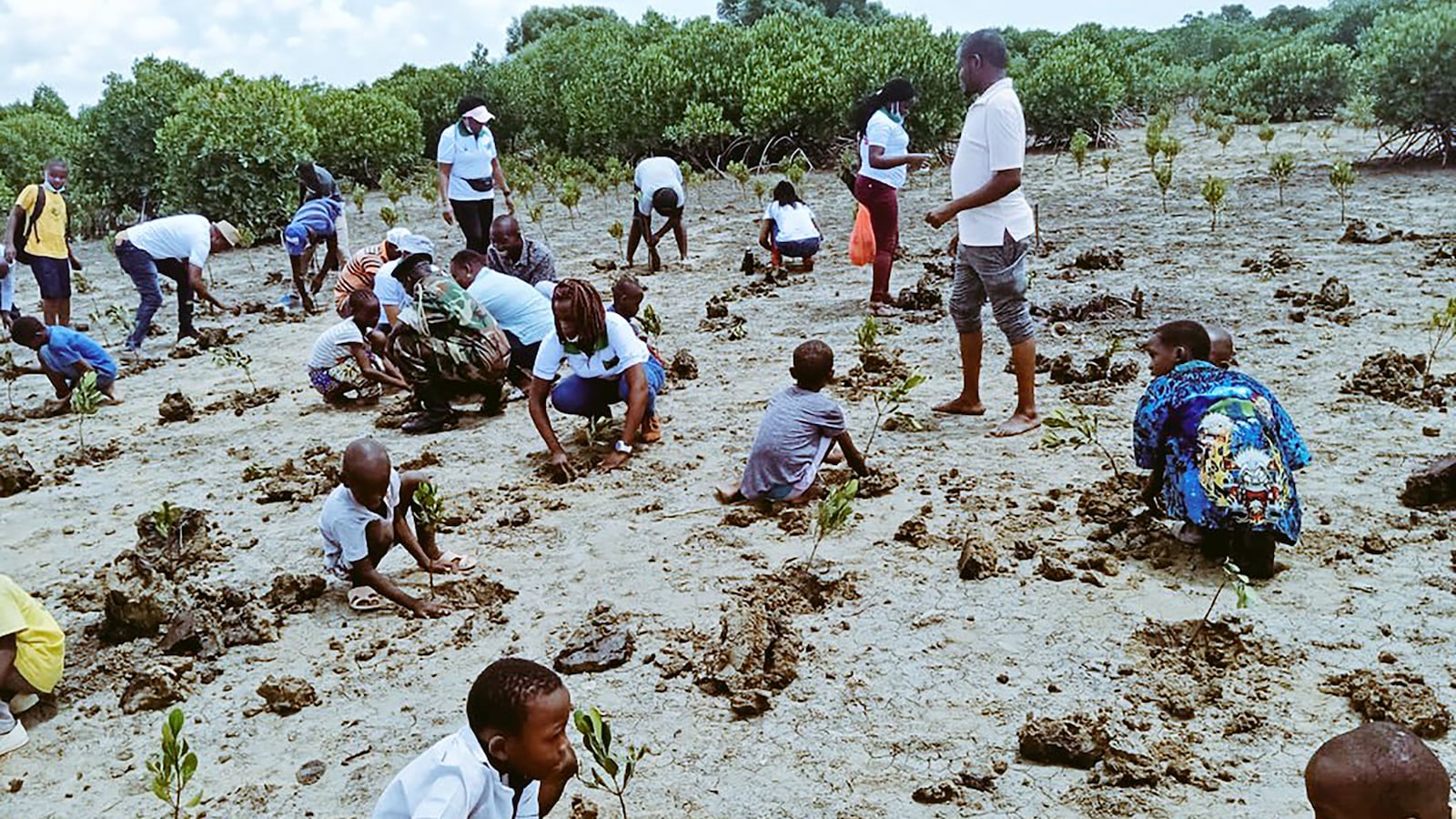Khamis Salim and the 25 other youths in his group were having a busy day when I first met him in November, at Tudor Creek along the coast of Kenya. Some were busy transplanting mangroves in mudflats, while others were engaged in scouting for illegal activities within the mangrove forest. Mangrove survival rates have dwindled to an all-time low, forcing the group to adopt a method of transplanting the trees in select rows 1.5 meters apart to keep them alive for longer. The youths’ mission: reverse years of damage caused by climate change to this vital tropical ecosystem.
Salim, 30, told The Daily Beast how important this mangrove species is to his community. When he was growing up, he witnessed how the illegal extraction of mangroves for construction, medicine, and charcoal burning ravaged his community, killing off much of the marine wildlife that many locals rely on as a source of food and income.
“People were cutting mangroves for construction and charcoal, not knowing how bad they were affecting fishing, which was so important to us,” said Salim.
To save his community from devastation, Salim founded the Manyunyu Community Organization, which has been restoring mangroves along along the Kenyan coast since 2007. The group has planted over 10,000 mangrove seedlings. It’s run entirely by young people, who have been thrust into the role of preventing the continued degradation of the mangrove ecosystems while the government remains absent. Every day, the group’s members wade through incredibly muddy thickets to safeguard the remaining fragments of the mangrove ecosystem.
“The youths in this group are all environment and climate change activists,” said Salim. “We know the vital role mangroves play to our community and in the world by reducing carbon emissions—hence our efforts in restoring them.”

A community gathering by the Manyunyu Community Organization at Tudor Creek near the Kenyan coastline to plant new mangrove seedlings.
Keit SilaleRapid Destruction, Rapid Action
UNESCO estimates that mangrove forests are disappearing three to five times faster than overall global deforestation. Current estimates suggest mangrove coverage has reduced by 35 percent in the last 20 years.
This is pretty disheartening news, considering how critical mangroves are to the ecological health of many environments around the world. They are brimming with wildlife, including 341 threatened species according to the Global Mangrove Alliance. These forests serve as a nursery for fish, supporting over 4.1 million fishermen worldwide. The dense, tangled roots and branches of the plant life act as a natural barrier against storm surges, floods, and dangerous winds—preventing more than $65 billion in property damages for coastal communities, and protecting more than 15 million people from floods.
And in the age of climate change, mangroves play an invaluable role in helping limit the impact of greenhouse gasses. They are among the most carbon-rich forests in the tropics, capable of sequestering up to four times more carbon per unit than terrestrial forests.
Few countries understand the critical importance of mangroves better than Kenya, where these forests cover about 148,000 acres of land along the country’s eastern coast. The health of the local ecology is critical to keeping the country's economy humming and sustaining the livelihoods of millions.
But since 1985, Kenya has lost one-fifth of its mangrove cover as a result of human activity. Economic decline has pressured struggling individuals and communities to illegally cut down mangrove forests and sell the wood as a construction material and fuel.
Across Africa, however, many people are choosing to take matters into their own hands to save this important ecosystem that thrives along the saltwater shorelines of 118 tropical and subtropical countries. On the frontline is a wave of young people, like those part of the Manyunyu Community Organization, who are mobilizing micro-movements to restore mangroves and take action against the climate crisis in a local setting.
Kenya is far from alone. Over the past few decades in Gambia, drought has laid waste to mangrove species near Anusmana Darboe’s home in the town of Sankadi, leaving the surrounding community in dire straits. “People from my community depend on fishing as their source of income, and when mangroves die, even the fish disappear, leaving many people to suffer,” Darboe told The Daily Beast.

The Global Greengrants Fund has helped sponsor youth-driven mangrove restoration efforts in Kenya and the rest of Africa.
Keit SilaleSeveral years ago, Darboe, 33, started the Sankadi Youth Development Organization, which works to restore mangroves in his community much in the same way that Salim and his group do so in Kenya. The mangrove restoration effort has been welcomed with warm arms so far, and the group has planted more than 150,000 seedlings. Fish populations are growing again, and the forests are once again resilient to strong storms.
“I work with community members and most of them are very cooperative when it comes to mangrove planting,” said Darboe. “This is a boost and a good gesture to show how saving mangroves is very important to all of us.”
Save the World, Get Paid
The big driver behind this movement is the emergence of carbon markets, which have given private companies flexibility in reaching net-zero carbon emissions and allow them to compensate for emissions by investing money toward endeavors like forest conservation. Mindful that this could be an opportunity to allow young people to make a living by fighting climate change, conservation groups in many parts of the world have begun to participate in the carbon credit trade business as well.
Mikoko Pamoja was the first community-led conservation group in Kenya to be certified for carbon credit trading by Plan Vivo, an international body that regulates carbon credits. The group sells at least 3,000 tons of carbon credits every year, with one ton going for approximately $5 to $8. Mikoko Pamoja started its carbon offset project only eight years ago. But in the past two years alone it has earned more than $30,000 and is now helping to support dozens of other groups along the Kenyan coast.
Salim Mwarima, who led Mikoko Pamoja’s carbon offset projects until recently, told The Daily Beast the group divides the mangrove forest into plots of 100 square meters and calculates the amount of potential carbon that can be stored in each plot. Then it calculates the rate of new mangrove growth needed to attain this storage carbon capacity. Then it gets to work planting those mangrove trees.
“Carbon credits depend on the quantity of carbon every mangrove plot stores,” said Mwarima. “So the higher the carbon, the more the credits we earn. And that motivates our community members to plant more mangroves.”
Ultimately, ecosystem restoration is emerging as a new way for much of the developing world to reduce poverty and build economic resilience. Last August, University of Tokyo researchers found that every dollar spent to restore habitats for plant and animal life can return up to $10.50 over the next 20 years.
But the effects of climate change are already being felt, increasingly impeding restoration efforts by washing away seedlings. Pollution and river damming are also an obstacle to making sure mangrove forests can be restored to healthy levels.
And mangrove restoration alone won't solve climate change. The world is witnessing hotter temperatures like never before, threatening the lives of billions. Jackson Kinyanjui, the founder of environmental organization Climate Change Kenya, told The Daily Beast he believes urgent attention should be shifted towards mitigating the climate crisis to save the future generation.

Mangroves forests can sequester several times more carbon than traditional forests, but the trees need to be planted with meticulous effort to grow effectively.
Keit Silale“We need to act to tackle the climate crisis at hand,” Kinyanjui said. “Our children are going to suffer if we are not going to act now and come up with policies to save the world.”
With the clock ticking and a lack of real government action, young people like those on the frontlines of the mangrove restoration efforts are simply pressing forward with their own efforts to stop climate change.
That’s not much of a surprise. Last September, a survey run by UK researchers found that nearly 45 percent of global youths have been directly affected by climate change. About 64 percent say their governments are not doing enough to avoid the effects of the climate crisis. And 75 percent are worried about their future as the climate crisis continues to worsen in many countries.
“It’s inherently important that youth take action against climate change as we will be the individuals to receive the direct, immensely destructive effects of climate change in the coming decades,” Gregor Sharp, one of the leaders of the American climate activist group Earth Uprising, told The Daily Beast. “Climate change will affect the youth of today and the coming generations of this world by degrading overall basic human rights. Pollution and natural disasters will cause an increase in damages toward basic infrastructure. Areas in which we currently live will become uninhabitable to human life.”
Still, every action matters. While the world continues to wait on national leaders and multinational businesses step up and impose meaningful action that will reduce carbon emissions, young people like Salim and the Manyunyu Community Organization have found a way to make a difference as a new way of making a living.

